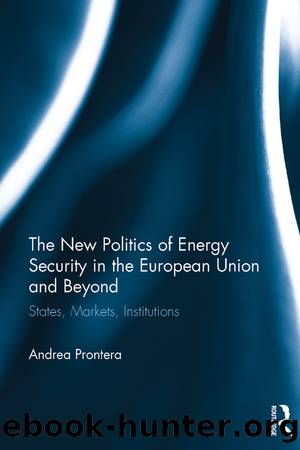The New Politics of Energy Security in the European Union and Beyond: States, Markets, Institutions by Andrea Prontera

Author:Andrea Prontera [Prontera, Andrea]
Language: eng
Format: epub
Tags: Political Science, General
ISBN: 9781317022688
Google: STgkDwAAQBAJ
Goodreads: 35193949
Publisher: Routledge
Published: 2017-05-18T00:00:00+00:00
Post-2014 Developments and the Politics of the East-West Energy Corridor after the Ukrainian War
The war in Eastern Ukraine, Moscowâs support for the separatist forces and the annexation of the Crimea drove relations between Russia and the EU to their lowest level since the end of the Cold War.35 There were several important consequences for East-West gas interdependence. First, the Kremlin and Gazprom decided to accelerate their gas export strategy based on diversification away from the Ukrainian route. In June 2015, Gazprom declared that after 2019 â when its main transit contracts with the Ukrainian company Naftogaz would expire â no more gas would be channelled to Europe via this route.36 In the following weeks, however, Putin directly reversed this decision, ordering Gazprom to negotiate new transit contracts with Naftogaz and the Ukrainian authorities.37 Indeed, as we saw, although additional diversification away from Ukraine remained a priority for the Kremlin and Gazprom, a complete transit diversification away from this route would have been very difficult to realise by 2019, both from a commercial point of view and because of the political opposition from the EU (Pirani and Yafimava 2016).
The second consequence was that the EU took a more direct role in mediating negotiations and agreements between Moscow and Kiev on transit issues and supplies to Ukraine and strengthened its bilateral cooperation with Kiev. The European Commission brokered trilateral agreements regarding transit issues and supplies â backed by EU financial assistance â with Russia and Ukraine to ensure the continuation of gas transit to Europe and gas imports to Ukraine. These trilateral agreements (the so-called âwinter packagesâ of 2014â15 and 2015â16) allowed the continuation of transit through Ukraine and guaranteed a minimum level of Russian gas imports to the country. The European Commission also promoted the establishment of reverse flows, mainly on the Slovakia-Ukraine gas interconnector, to supply Ukraine: between July 2014 and June 2015, Ukraine imported about 10 bcm of gas from the EU, which accounted for more than 70 percent of total Ukrainian gas imports during that period (European Commission 2015a). The EU and Ukraine also improved bilateral cooperation during this time. In June of 2014, they signed the Association Agreement, and in the Energy Union package of February 2015, the EU proposed an upgrade to its Strategic Partnership with Kiev (European Commission 2015b). A Memorandum of Understanding, backed by 1.8 billion euros of financial assistance, including energy as well as other sectors, was then signed by the EU and Ukraine in May 2015.38 Then, at the beginning of September 2016, the European Commission reasserted its proposal for relaunching trilateral talks with Kiev and Moscow to mediate a third gas deal for the winter of 2016â17.
Finally, the third consequence was that the EU assumed a more assertive political position towards the Russian strategy of building pipeline routes outside Ukraine. This position also aimed to preserve the economic benefits Ukraine enjoys as transit country. However, this position â supported by EU institutions â was not equally supported by all member states and European energy companies, as demonstrated by the plans for the Nord Stream 2 project.
Download
This site does not store any files on its server. We only index and link to content provided by other sites. Please contact the content providers to delete copyright contents if any and email us, we'll remove relevant links or contents immediately.
The Complete Stick Figure Physics Tutorials by Allen Sarah(7265)
Secrets of Antigravity Propulsion: Tesla, UFOs, and Classified Aerospace Technology by Ph.D. Paul A. Laviolette(5237)
Thing Explainer by Randall Munroe(3849)
The River of Consciousness by Oliver Sacks(3498)
The Order of Time by Carlo Rovelli(3097)
How To by Randall Munroe(2970)
A Brief History of Time by Stephen Hawking(2912)
I Live in the Future & Here's How It Works by Nick Bilton(2900)
The Great Unknown by Marcus du Sautoy(2613)
What If?: Serious Scientific Answers to Absurd Hypothetical Questions by Randall Munroe(2590)
Midnight in Chernobyl by Adam Higginbotham(2433)
Blockchain: Ultimate Step By Step Guide To Understanding Blockchain Technology, Bitcoin Creation, and the future of Money (Novice to Expert) by Keizer Söze(2410)
Networks: An Introduction by Newman Mark(2304)
The Meaning of it All by Richard Feynman(2268)
Easy Electronics by Charles Platt(2252)
The Tao of Physics by Fritjof Capra(2204)
Midnight in Chernobyl: The Untold Story of the World's Greatest Nuclear Disaster by Adam Higginbotham(2127)
When by Daniel H Pink(2057)
Introducing Relativity by Bruce Bassett(2048)
